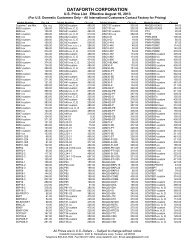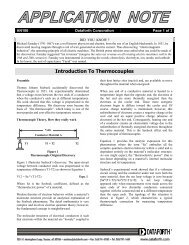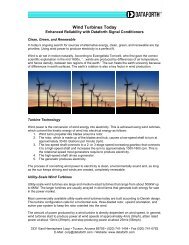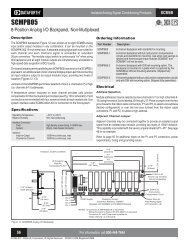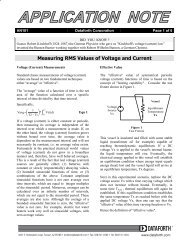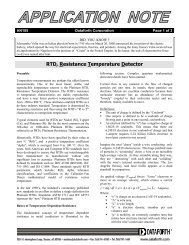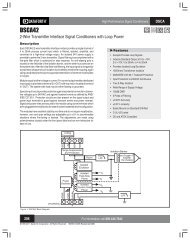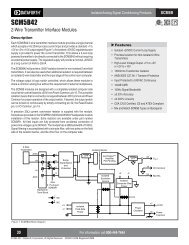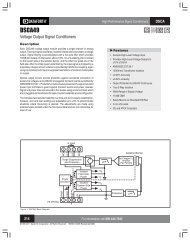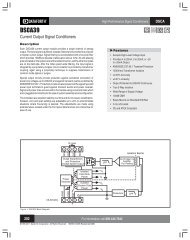AN107 <strong>Dataforth</strong> Corporation Page 2 of 8Three additional thermocouple types used for hightemperature measurements are C, D, and G Typethermocouples. Their designation letters (C, D, G) are notrecognized as standards by ANSI; nonetheless, they areavailable. Their wire compositions are;G Type: W vs W-26%ReC Type W-5%Re vs W-26%ReD Type W-5%Re vs W-25%ReWhere; “W” is Tungsten and “Re” is RheniumMost all practical temperature ranges can be measuredusing thermocouples; even though, their output full-scalevoltage is only millivolts with sensitivities in themicrovolts per degree range and their response is nonlinear.Figures 3 and 4 at the end of this Application Notedisplays typical voltage-temperature characteristics of theabove thermocouples. These curves provide a visualindication of thermocouple ranges, scale factors,sensitivities, and linearity<strong>Dataforth</strong> offers thermocouple input modules, whichinterface to all the above types. For more details on theseand other state-of-the-art modules, visit <strong>Dataforth</strong>’swebsite, Reference 2.The <strong>Thermocouple</strong> Analytical ModelStandard mathematical power series models have beendeveloped for each type of thermocouple. These powerseries models use unique sets of coefficients which aredifferent for different temperature segments within agiven thermocouple type. Unless otherwise indicated, allstandard thermocouple models and tables are referencedto zero degrees Centigrade, 0°C. The reader is referred to<strong>Dataforth</strong>’s Application Note AN106, “Introduction to<strong>Thermocouple</strong>s” for the fundamentals of thermocouples,Reference 8.Reference for the following examples and associated datais the NIST, National Institute of Standards and Testing;website, Reference 1.Equation 1 illustrates the power series model used for allthermocouples except K Type, which is illustrated byEqn. 3niVTC = ∑ Ci× ( T ) ,mV Eqn. 1i=0Where T is in degrees CThe set of coefficients used in Eqn. 1 to model E Typethermocouple is shown for 3 significant digits in Table 2.CoefficientsC CoefficientsiC iTable 2for Type E <strong>Thermocouple</strong>Value-270 to 0 °C(mV/°C)Value0 to 1000 °C(mV/°C)C0 0.00E+00 0.00E+00C1 5.87E-02 5.87E-02C2 4.54E-05 4.50E-05C3 -7.80E-07 2.89E-08C4 -2.58E-08 -3.31E-10C5 -5.95E-10 6.50E-13C6 -9.32E-12 -1.92E-16C7 -1.03E-13 -1.25E-18C8 -8.04E-16 2.15E-21C9 -4.40E-18 -1.44E-24C10 -1.64E-20 3.60E-28C11-3.97E-23C12-5.58E-26C13-3.47E-29These equations with their different sets of coefficientsare difficult to use in directly determining actualtemperatures when only a measured thermocouple voltage[VTC] is known. Therefore, inverse models have beendeveloped to determine temperatures from measuredthermocouple voltages. Equation 2 represents this inversemodel.niT = ∑ Di× ( VTC) , °C Eqn. 2i = 0Where VTC is in millivoltsThe sample set of inverse coefficients for E Typethermocouples is shown for 6 significant digits in Table 3.Table 3Inverse Coefficients for E Type <strong>Thermocouple</strong>D i InverseCoefficientsRange–220 to 0 °CValue-8.825 to 0 mV(°C/mV)Range0 to 1000 °CValue0 to 76.373 mV(°C/mV)D0 0.00000E+00 0.00000E+00D1 1.69773E+01 1.70570E+01D2 -4.35150E-01 -2.33018E-01D3 -1.58597E-01 6.54356E-03D4 -9.25029E-02 -7.35627E-05D5 -2.60843E-02 -1.78960E-06D6 -4.13602E-03 8.40362E-08D7 -3.40340E-04 -1.37359E-09D8 -1.15649E-05 1.06298E-11D9 0.00000E+00 -3.24471E-14
AN107 <strong>Dataforth</strong> Corporation Page 3 of 8It is noteworthy to mention here that K Typethermocouples require a slightly different power seriesmodel. Equation 3 represents the standard mathematicalpower series model for Type K thermocouples.nVTC = C × T + A × ei = 02iA1×( T- A2)∑ i ( ) 0,mV Eqn. 32A1 ( T- A2)The exponential term [ A0× e × ] in Eqn. 3 isadded to account for special effects. More details on thistype thermocouple model are available from NIST website, Reference 1.Cold Junction Compensation (CJC) TechniqueStandard thermocouple look-up tables and models arereferenced to zero °C; whereas, field measurementtopologies are made with the thermocouple connected to aconnector that is not at zero °C; consequently, the actualmeasured voltage must be adjusted so that it appears asreferenced to zero °C.Modern signal conditioning modules have electronicallyresolved this situation and, in addition, have linearized thethermocouple voltages. These conditioning modulesprovide the end-user with a linear output signal, scaled toeither volts per °C (°F) or amps per °C (°F). The conceptof electronically referencing thermocouple measurementsto zero °C is shown in Figure 1. This technique is knownas “cold junction compensation” or CJC.V1 = S*(Tx-Tc) Eqn. 4V2 scaled to = S*(Tc-Tice) Eqn. 5Where Tice is zero °C or 32°FThe reader is referred to Reference 8, <strong>Dataforth</strong>’sApplication Note AN106 for the derivation of theseexpressions.Equation 4 can be mathematically rearranged to includethe ice-point temperature (Tice).V1 = S*(Tx-Tice) - S*(Tc-Tice) Eqn. 6Equation 6 shows the thermocouple voltage (V1) has twoparts, both of which are referenced to Tice. The voltageterm, S*(Tx-Tice), is the standard look-up table valueneeded for determining the unknown temperature (Tx).The term, S*(Tc-Tice), is the voltage obtained ifconnector temperature (Tc) were measured with the sametype thermocouple as used to measure Tx. Recall that V2has been electronically scaled so that V2 equals thisvoltage, V2 = S*(Tc-Tice). In Figure 1 if G = 1, then;Vout = (V1+V2)*G = S*(Tx-Tice), G = 1 Eqn. 7The output voltage (Vout) in Equation 7 can be entereddirectly into the appropriate type thermocouple referencetable to determine the measured temperature.LinearizationV1Tx(V1+V2)*GV2Tc<strong>Thermocouple</strong> Connector OutputVoutAccurate thermocouple measurements need signalconditioning modules with outputs, which are linearlyscaled to temperature. Module output voltages whichhave linear scale factors in volts per degree or amps perdegree eliminate the need for look-up tables or powerseries expansions since the conversion from thermocouplevolts to temperature is built into the linearized outputscale factor. Such thermocouple signal conditioningmodules including isolation and CJC are available from<strong>Dataforth</strong>.Figure 1Cold Junction Compensation ConceptIn Figure 1, the voltage V1 is Seebeck’s thermocouplevoltage generated by the difference between the unknowntemperature (Tx) and the connector temperature (Tc), asshown in Equation 4. The connector temperature (Tc) ismeasured with a non-thermocouple sensor (diode, RTD,etc.) and the corresponding sensor voltage (V2) iselectronically scaled to represent the same Seebeckthermocouple voltage (referenced to 0°C) that athermocouple would read if used to measure Tc asindicated in Eqn. 5. This “V2 scaling” is matched to thesame type thermocouple as used to measure Tx.Figure 3 displays the voltage–temperature curves for eightof the most common thermocouples. These curves arepresented here to show a visual indication of standardthermocouple ranges, magnitudes of output voltages, nonlinearityand sensitivity (mV/°C). Although theoperational temperature ranges over which thermocouplescan be used is quite large, their sensitivity is small; in themicrovolt per °C range. In addition, Figure 3 illustratesthat for negative temperatures, thermocouples’ response isvery non-linear; however, these curves appear near linearfor certain ranges of positive temperatures. Nonetheless,the fact remains that thermocouples are non-linear.




